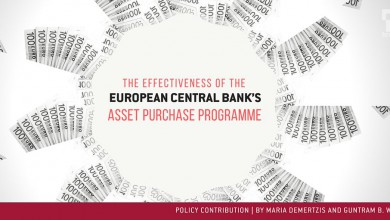The potential effects of global integration on inflation dynamics, and whether this could affect the ability of central banks to fulfil their mandates. This post was first published on Bruegel.
After soaring in the 1970s, inflation rates in advanced countries have declined significantly since the early 1980s, stabilized around 2% in the years before the global financial crisis, and are today at very low levels (see Figure 1). This movement coincided with the acceleration of globalisation, triggering a debate on whether globalisation could be one of the main drivers of the disinflation process, and whether the ability of central banks to control inflation could be undermined as a result.
Figure 1: Headline inflation percentile distribution across the world
Notes: distribution of year-on-year inflation across an unbalanced panel of 50 countries.
Source: OECD Economic Outlook and Bruegel calculations.
In a recently published paper, we reviewed the potential effects of global integration on inflation dynamics, and discussed whether this could affect the ability of central banks to fulfil their mandates.
The recent acceleration in globalisation has mainly taken three forms that could affect inflation dynamics and monetary policy: trade integration, labour market integration and financial integration. Openness in terms of trade has led to a greater sensitivity of domestic price levels to external price shocks. Fluctuations in global prices can indeed have major temporary effects on domestic prices: as can be seen in Figure 2, energy prices are one of the major determinants of the short-term fluctuations of the euro-area headline inflation. More importantly, trade with low-cost countries has increased massively in the last two decades, which has logically resulted in a reduction in the price of imported goods. Global competition between firms might have also reduced the pricing power of domestic companies, while the integration of billions of workers into the global labour market has likely reduced the bargaining power of domestic workers. Overall, the empirical literature – Pain, Koske and Sollie (2006) – shows that the contribution of globalisation to the global disinflation movement since the 1990s has been positive, but rather limited for the moment.
Figure 2: Headline, core, energy and food inflation, Euro area (%)
Source: Eurostat.
A more important question in our view is whether these integration trends affect the transmission mechanisms of monetary policy and reduce the ability of central banks to fulfil their mandate. The transmission channels of monetary policy could potentially be affected at various levels. First, central banks could lose their ability to control inflation if inflation becomes a function of global slack instead of being a function of domestic slack. Second, central banks could lose control of short-term rates if rates become a function of global liquidity instead of the liquidity provided by the domestic central bank. And third, central banks could lose their hold over domestic inflation and economic activity if long-term interest rates depend only on the balance between savings and investment at the global level, and not at the domestic level.
It is true that the negative relationship between domestic slack and domestic inflation has changed and that that the slope of the so-called Phillips curve has flattened since the mid 1980s. In other words, the rate of unemployment triggering wage increases and inflation is lower today than in the past. However, empirical studies – Ihrig et al (2007) and Ball (2006) – have failed to demonstrate that globalisation had been one of the main drivers behind this trend. A more plausible explanation seems to lie in the monetary policy changes that have taken place since the mid 1980s, with the adoption of credible inflation-targeting regimes in many advanced countries. These policies, combined with the move away from indexation of wages, have made external price shocks much less persistent than in the 1970s thanks to the absence of the second-round effects. Indeed, figure 2 suggests a low pass-through of recent external price shocks (e.g. from oil prices) from the headline inflation rate to the core measure.
Concerning the control of central banks over the domestic yield curve, it is clear that as long as central banks retain some kind of domestic monopoly over the issuance of base money, they will be able to control the shorter end of the domestic yield curve. For long-term rates, this is less clear, however. The conundrum episode of 2004-06 in the US (see Figure 3) suggests that long-term rates can become less sensitive to short-term rates and that external factors can affect them significantly. Since the beginning of the crisis, central banks also showed that they were willing to use less conventional monetary tools in order to influence the whole yield curve, in particular when they are constrained at the short end of the curve by the zero lower bound.
Figure 3: US short and long term interest rates
Source: FRED (Saint Louis Fed)
In any case, even if financial integration could result in a reduction of the role of the long-term interest rate channel, for countries accepting flexible rates globalisation should at the same time increase the role of the exchange rate as a transmission mechanism. Indeed, the disappearance of capital controls and the reduction in the portfolio home bias in many advanced countries mean that financial markets are much more integrated than a few decades ago and that the demand for domestic and foreign assets is more sensitive to differences in interest rates, thus enhancing the influence of monetary policy on the exchange rate.
Given the potentially greater effects of external price shocks on more open economies and the potential alteration of monetary policy transmission channels in more integrated financial markets, globalisation forces central banks to take external developments into account in their monetary policy decisions. In particular, central banks need to have a medium-term policy goal orientation instead of trying to manage yearly inflation rates that are driven by global shocks. Overall, we think that, as long as they adopt flexible exchange rates, central banks retain their ability to stabilise inflation at the targeted level in the medium term, even though globalisation does not facilitate their task, which is already quite difficult because of the zero lower bound.




